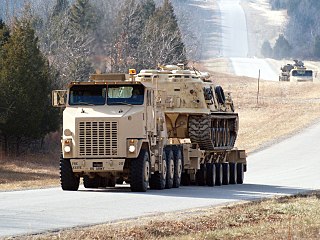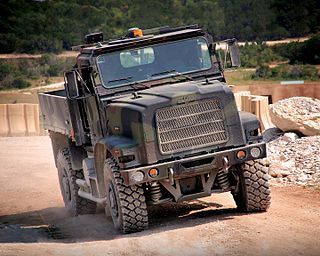 W
WThe Family of Medium Tactical Vehicles (FMTV) is a series of vehicles, based on a common chassis, that vary by payload and mission requirements. The FMTV is derived from the Austrian Steyr 12 M 18 truck, but substantially modified to meet U.S. Army requirements, these including a minimum 50 percent U.S. content.
 W
WHeavy Equipment Transporter System (HETS) is the name of a U.S. Army logistics vehicle transport system, the primary purpose of which is to transport the M1 Abrams tank. It is also used to transport, deploy, and evacuate armored personnel carriers, self-propelled artillery, armored bulldozers, and other heavy vehicles and equipment.
 W
WThe Heavy Expanded Mobility Tactical Truck (HEMTT) is an eight-wheel drive, diesel-powered, 10-short-ton (9,100 kg) tactical truck. The M977 HEMTT first entered service in 1982 with the United States Army as a replacement for the M520 Goer, and since that date has remained in production for the U.S. Army and other nations. By Q2 2021, around 35,800 HEMTTs in various configurations had been produced by Oshkosh Defense through new-build contracts and around 14,000 of these had been re-manufactured. Current variants have the A4 suffix.
 W
WThe Logistics Vehicle System (LVS), nicknamed by U.S. Marines as "Dragon Wagon", is a modular assortment of eight-wheel drive all-terrain vehicle unit combinations used by the United States Marine Corps.
 W
WThe Medium Tactical Vehicle Replacement (MTVR) is a series of vehicles, based on a common chassis that vary by payload and mission requirements. The MTVR is a purpose-designed military vehicle, although a small number of vehicles have been sold commercially for specialized operations such as wildfire fighting.
 W
WThe Next Generation Delivery Vehicle (NGDV) will be a mail truck for the United States Postal Service. The contract award was made to Oshkosh Corporation in February 2021, is valued at up to $6 billion, and up to 160,000 vehicles will be built in a new facility. The award has been protested by losing bidder Workhorse.
 W
WThe Oshkosh Alpha is a Mine-Resistant Ambush Protected (MRAP) vehicle created by Oshkosh Corporation together with Protected Vehicles Incorporated (PVI). It is considered as a Category I MRAP vehicle.
 W
WThe Oshkosh L-ATV is a light utility/combat multi-role vehicle that won the US military's Army-led Joint Light Tactical Vehicle (JLTV) program. In the very early stages of the program it was suggested that JLTV would replace the AM General High Mobility Multi-purpose Wheeled Vehicle (HMMWV) on a one-for-one basis. It is now suggested that the JLTV will part-replace the HMMWV, not replace it on a like-for-like basis.
 W
WThe Oshkosh M-ATV is a Mine-Resistant Ambush Protected (MRAP) vehicle developed by the Oshkosh Corporation for the MRAP All Terrain Vehicle (M-ATV) program. Intended to replace M1114 HMMWVs (Humvee), it is designed to provide the same levels of protection as the larger and heavier previous MRAPs, but with improved mobility.
 W
WThe Oshkosh M1070 is a U.S. Army tank transporter tractor unit. In current service in A0, A1, and M1300 configurations, the M1070 is coupled to a DRS Technologies M1000 semi-trailer. The primary purpose of this combination for the U.S. Army is the transport of the M1 Abrams tank. The M1300, covered in a separate sub-section, is a U.S. Army Europe-specific derivative designed to be road legal within Europe and operates with a different trailer.
 W
WThe Oshkosh Striker is a specialized aircraft rescue and firefighting (ARFF) vehicle built by Oshkosh Corporation at the Pierce Mfg. facilities Appleton, Wisconsin. There are three models of the Striker: 1500, 3000, 4500. All models are available with a snozzle capable of piercing an aircraft fuselage to dispense fire retardant material within a cabin or cargo area.
 W
WTAK-4 independent suspension system is a family of independent suspension systems designed and manufactured by Oshkosh Corporation for use on military, severe-duty and emergency vehicles. The system was developed from the mid-1990s.
 W
WThe Oshkosh P-19R is an Aircraft Rescue and Fire Fighting (ARFF) vehicle and it was selected by the U.S. Marines in 2013. The first delivery occurred in June 2017, Initial Operating Capability (IOC) followed in February 2018, and in service the P-19R serves as a first-response vehicle in aircraft fire emergencies at military bases and expeditionary airfields.
 W
WThe Palletized Load System (PLS) is a truck-based logistics system that entered service in the United States Army in 1993. It performs long and short distance freight transport, unit resupply, and other missions in the tactical environment to support modernized and highly mobile combat units. It provides rapid movement of combat configured loads of ammunition and all classes of supply, shelters and intermodal containers. It is similar to systems such as the British Demountable Rack Offload and Pickup System (DROPS).
 W
WThe SandCat is a composite armored vehicle designed by the then Plasan Sasa of Israel. The SandCat, which is presented as a single bi-capitalized word, was shown publicly for the first time at AUSA during October 2005. The latest models were shown for the first time at Eurosatory 2018. The SandCat is based on a commercial Ford F-Series chassis. Approximately 700 SandCats have been produced since 2004, and while Plasan has never released complete details, these are known to be in service with at least 16 users across five continents, and in a wide variety of roles that range from Police/internal security to combat/patrol.
 W
WThe R-11 Refueler replaced the R-9 Refueler as the primary mobile refueling vehicle for The United States Air Force. There are currently three models of the R-11. The first generation was delivered in 1989 to the Air Force by the Oshkosh Truck Corporation and is commonly referred to as the Oshkosh R-11. The Air Force purchased 1,250 Oshkosh R-11s between 1987 and 1991. Deliveries of the second generation R-11 began in 1994. The contract for the second generation model was awarded to the Kovatch Corporation, and the pumping and dispensing systems are mounted on a Volvo chassis. These models are commonly referred to as the Volvo R-11. Deliveries of the third generation R-11 began in 2004. The contract for this model was also awarded to the Kovatch Corporation, and the pumping and dispensing systems are mounted on an International chassis. This model is commonly referred to as the International R-11. There is a new specification that has been manufactured by ATAP, Inc.
 W
WTerraMax is the trademark for autonomous/unmanned ground vehicle technology developed by Oshkosh Defense. Primary military uses for the technology are seen as reconnaissance missions and freight transport in high-risk areas so freeing soldiers from possible attacks, ambushes or the threat of mines and IEDs. The technology could also be used in civilian settings, such as autonomous snow clearing at airports.